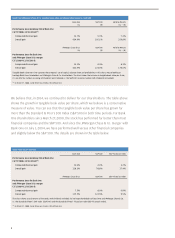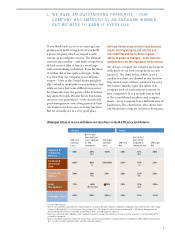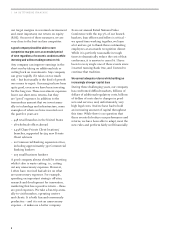JP Morgan Chase 2014 Annual Report Download - page 16
Download and view the complete annual report
Please find page 16 of the 2014 JP Morgan Chase annual report below. You can navigate through the pages in the report by either clicking on the pages listed below, or by using the keyword search tool below to find specific information within the annual report.
1414
I. AN OUTSTANDING FRANCHISE
better o or worse o because of some of the
great products and services that come with
complexity? The answer in our opinion is a
resounding yes, though you should always
strive to minimize the risks. But we want to
acknowledge that the dierence with banks,
as pointed out by critics, is that if and when
they make mistakes, they can severely harm
the economy. This concern is legitimate, and I
will talk about it in a later section.
Larger does not necessarily mean more risky
For example, many large banks had no
problem navigating the financial crisis,
while many smaller banks went bankrupt.
Many of these smaller banks went bankrupt
because they were undiversified, meaning
that most of their lending took place in a
specific geography. A good example was
when oil collapsed in the late 1980s. Texas
banks went bankrupt because of their direct
exposure to oil companies and also because
of their exposure to real estate whose value
depended largely on the success of the oil
business. Since the crisis began seven years
ago, more than 500 smaller banks have gone
bankrupt, and JPMorgan Chase has contrib-
uted approximately $8 billion to the Federal
Deposit Insurance Corporation to help pay
for the resolution of those banks.
And, yes, there are both costs and benefits to
size and complexity
The benefits of size are obvious: huge econo-
mies of scale, the ability to serve large clients
and make large investments, and safe diversi-
fication, among others. And, yes, there some-
times are clear negatives to size – usually in
the form of arrogance, greed, complacency
or lack of attention to detail. (There also are
many small businesses aicted with these
diseases – they kill companies both large
and small.) Good companies get the benefits
of size and continuously are fighting o the
negatives. And there are lots of winners and
losers, particularly as industries consolidate.
In every industry, you will see companies
that benefit from size – and those that don’t.
Our size and strength allow us to create
benefits for society by helping economies
and communities around the world grow and
prosper
We are able to do our part in supporting
communities and economies around the
world because we are strong, stable and
permanent. And because of this strength
and stability, we can continue to support our
clients in good times and, more important,
in the toughest of times. The most important
thing we can do is keep our company healthy
and vibrant so that we can serve the needs
of customers, consumers and businesses and
help local economies and the thousands of
cities and various communities around the
world where we operate to grow and prosper.
In addition, we strongly believe in being a
good corporate citizen. We are one of the
most philanthropic companies in the world
(we give away more than $200 million a
year), but we are able to do much more than
provide money. We bring the skills, resources
and global knowledge of our entire firm
to support the economic growth and prog-
ress of communities across the globe. One
example is our research, such as studying
how our communities analyze labor market
conditions so they can get better at training
people for jobs or how cities can further
develop their economies. See Peter Scher’s
Corporate Responsibility letter on page 58
for more details on our eorts to support
cities and communities around the globe.
Following are three unique initiatives that
we’d like to focus on:
JPMorgan Chase Institute. We will be o-
cially launching an exciting new initiative
called the JPMorgan Chase Institute, which
is a global think tank dedicated to deliv-
ering data-rich analyses, expert insights
and thought leadership for the public good.
Drawing on the knowledge, market access,
broad relationships and resources across
the firm, the JPMorgan Chase Institute will
help inform both business and policy deci-
sions by grounding them with facts, data
and thoughtful analysis. Our aim is to help
decision makers – policymakers, businesses
and nonprofit leaders – appreciate the scale,
























